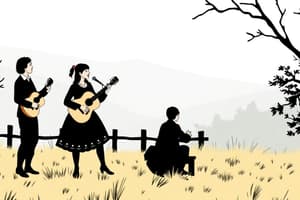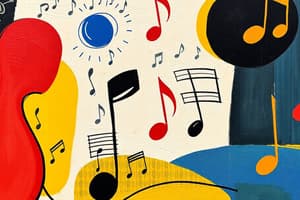Podcast
Questions and Answers
Which characteristic distinguishes Romantic art song from earlier vocal music forms?
Which characteristic distinguishes Romantic art song from earlier vocal music forms?
- Exclusively uses orchestral accompaniment.
- Focuses primarily on religious themes.
- Strict adherence to traditional musical structures.
- Intimately fuses poetry and music, emphasizing personal expression. (correct)
How does the piano accompaniment contribute to the emotional impact of a Romantic art song?
How does the piano accompaniment contribute to the emotional impact of a Romantic art song?
- By strictly imitating the vocal melody.
- By remaining rhythmically static throughout the song.
- By simply providing harmonic support to the vocal line.
- By enhancing the mood and meaning of the text through independent melodic, rhythmic, and harmonic material. (correct)
What is the significance of the 'Lied' in the context of Romantic art song?
What is the significance of the 'Lied' in the context of Romantic art song?
- It refers to a specific type of operatic aria.
- It denotes a short instrumental interlude within the song.
- It is the German term for 'art song,' typically for solo voice and piano. (correct)
- It indicates a song written exclusively for royal patrons.
In 'through-composed' form, how does the music relate to the poem's structure and content?
In 'through-composed' form, how does the music relate to the poem's structure and content?
How did Franz Schubert contribute to the development of the Romantic art song?
How did Franz Schubert contribute to the development of the Romantic art song?
What role does 'imagination' play in Romantic art song, as reflected in the characteristics of the Romantic era?
What role does 'imagination' play in Romantic art song, as reflected in the characteristics of the Romantic era?
In art song, what is the relationship between the melody and the text?
In art song, what is the relationship between the melody and the text?
What does the term 'strophic' mean in the context of musical form of art songs?
What does the term 'strophic' mean in the context of musical form of art songs?
Which element is NOT a defining characteristic of an art song?
Which element is NOT a defining characteristic of an art song?
What is the purpose of a 'postlude' commonly found in Romantic art songs?
What is the purpose of a 'postlude' commonly found in Romantic art songs?
Flashcards
Art Song
Art Song
A musical composition for solo voice and piano, setting a poem to music, primarily from the Romantic period.
Lied/Lieder
Lied/Lieder
Musical setting of a poem for solo voice and piano, typically in German.
Romantic Period Characteristics
Romantic Period Characteristics
Emphasis on emotion, individualism, and imagination, often inspired by literature.
Franz Schubert
Franz Schubert
Signup and view all the flashcards
Through-Composed Form
Through-Composed Form
Signup and view all the flashcards
Strophic Form
Strophic Form
Signup and view all the flashcards
Melody
Melody
Signup and view all the flashcards
Accompaniment
Accompaniment
Signup and view all the flashcards
Postlude
Postlude
Signup and view all the flashcards
Study Notes
- Romanticism emphasizes emotion, individualism, and imagination, often drawing inspiration from literature.
Art Song Defined
- An art song is a musical composition for piano and solo voice, primarily featured in opera plays.
- Superior to spoken poetry due to its melodic nature, it's also known as "Lied" (singular) or "Lieder" (plural) in German.
- The theme is based on poem
Franz Schubert
- Franz Schubert was a German composer and "Master of the Art Song".
- Schubert bridged the Classical and Romantic periods and introduced the Roman art song
- Known for Lieder, which set German poetry to music for a single vocalist.
- Considered among the first Romantic composers.
Elements of Art Song Explained
- Art songs are short vocal music pieces for solo voice and piano, distinctive to the Romantic era
- Art songs are lyrical and expressive, blending poetry and music.
- The melody is poetic and lyrical, turning words into musical scenes.
- Rhythm is needed to create a musical pitch
- The treble clef is also known as the G-clef.
- The bass clef is also known as the F-clef.
Accompaniment
- Piano accompaniment enhances the mood and meaning, adding harmonic, rhythmic, and melodic material. Harmonic being blend, rhythmic being together, and melodic being in sequence.
Form
- The musical form depends on poetic structures which can be through-composed or strophic.
- In through-composed form, each stanza has "different" music that follows the poem's ideas and moods.
- Strophic form uses "the same music" in each stanza; modified strophic form uses modified versions.
- Some songs are partly strophic, with some stanzas sharing music and others differing.
Characteristics of an Art Song
- Art Songs are accompanied by the piano using virtuoso technique
- Art songs have high artistic and literary quality.
- Art songs typically end with a piano postlude.
Studying That Suits You
Use AI to generate personalized quizzes and flashcards to suit your learning preferences.




